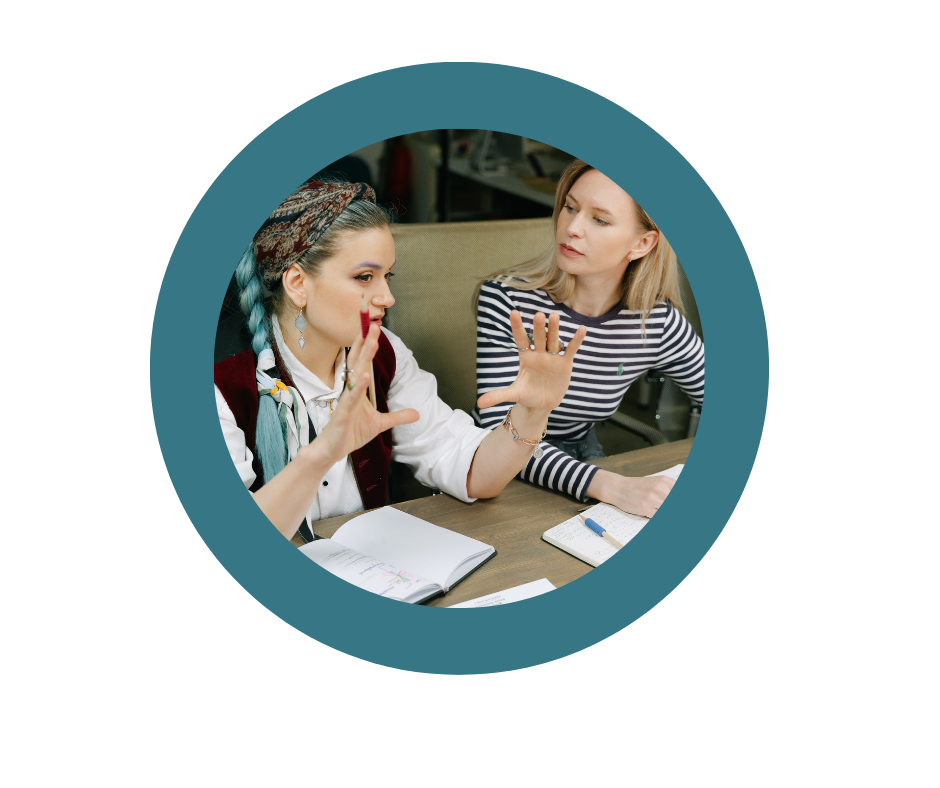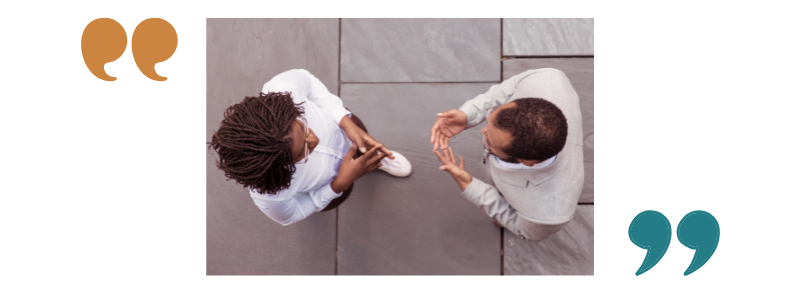
Storytelling for learning and development
The examples in this section showcase some useful approaches to using stories to help us talk and learn together.

Stories make an excellent stimulus for talking and learning together. We can use storytelling methods in lots of different ways to help people learn and develop their skills
Appreciative Inquiry
Written by Roger Rowett
Appreciative Inquiry is an approach that values the best in an organisation, group, or individual. It takes its roots from positive psychology, storytelling, and principles such as the belief that we construct our image of the world through our interactions with others. It has a well-used methodology, called the 5D cycle that takes people through a process of:
- define
- discovery
- dreaming
- design
- destiny.
This method is used across social care and health, and many different organisations.
Find out more:
Community Reporting
Written by Hayley Trowbridge
Community Reporting is a peer-to-peer, digital storytelling method that supports people’s participation in research, policymaking, service development, and decision-making processes. It helps people to tell their own stories, in their own way through text, photos, audio and video.
Community Reporting has three stages:
- gathering stories: supporting people to share stories about topics that matter to them
- curating stories: identifying the key insights in a set of stories and packaging the findings
- mobilising stories: connecting the story insights with people in a position to make change.
Community Reporting is a framework through which people’s stories are transformed into real-world change. You can find out more about the method on this animation: https://www.youtube.com/watch?v=ILRvHwHEKzY
People’s Voice Media has been developing this approach to digital storytelling since 2007 and building a community of people and organisations around it. The Community Reporter Network now spans the UK and Europe. It has more than 50 active partner organisations from different sectors in the arenas of policy, research and services, and has trained over 2,000 Community Reporters.
Find out more:
https://www.youtube.com/watch?v=VjOTRmIyS8M
Magic/Tragic Moments
Written by Nick Andrews
Magic/Tragic Moments is a storytelling approach to learning and development, that’s based on Experience Based Co-Design (Bate and Robert, 2007). It involves gathering and collectively exploring short stories of experience with a focus on the highs and the lows.
These stories can be gathered from practitioners and the people they work with. They are then discussed and explored in groups, with a focus on what makes them ‘magic’ or ‘tragic’ and the implications for policy and practice development.
Find out more:
There's more detail on this method in the DEEP handbook, which you can find on this page: Developing Evidence Enriched Practice (DEEP).
Most Significant Change
Written by Nick Andrews
Most Significant Change (MSC) is a storytelling and learning approach to evaluation. It’s designed for use in services, projects or programmes that are focused on change (Davies and Dart, 2005). The stories of change are gathered over a specific time period and follow a set structure:
- thinking back over the last x months, what good or bad changes have come about as a result of the service/project/programme?
- of these changes, which is the most significant to you and why?
- regarding this most significant change, please can you describe what it was like before, what it’s like now and what brought about the change?
- please give your story a snappy title.
A selection of MSC stories can be explored and discussed in Story Selection Panels, which include individuals with strategic decision-making powers and other stakeholders. These panels talk about the stories. They produce a report sharing which story for them was the most significant, what they have learned from all the stories and the implications for policy and practice development. The stories can also be explored in other ways too. For example, qualitative analysis can explore what themes are present in the stories.
Find out more:
There's more detail on MSC in the DEEP handbook, which you can find on this page: Developing Evidence Enriched Practice (DEEP).
Read more in Nick's blog post on MSC here: From metrics to meaning: Most Significant Change as a learning-focused approach to evaluation in Wales.
This video explores the method and its benefits from the viewpoint of people working in social care, health and the third sector. It was filmed at an MSC event organised by DEEP in March 2025.
Welsh and English subtitles are available in the settings.
Patient Voices
Written by Pip Hardy
Patient Voices was founded in 2003 by Pip Hardy and Tony Sumner. It uses digital storytelling as a platform for first-person stories.
It was established to redress the balance of power between healthcare providers and the people who access services and to give decision-makers an opportunity to understand the needs of patients and families. It’s more powerful and compelling than the dry results of surveys and statistics.
There are now around 1000 stories on the website, all freely available for use in education and service improvement initiatives. The Patient Voices Programme has won many international awards, including the British Medical Journal award for excellence in healthcare education.
Find out more:

Stories about health and illness
The Narrative Practices Lab
Written by Laura Mazzoli-Smith
Researchers work with digital stories and explore how storytelling becomes evidence in health research and care. The stories present the different elements of lived experience (for example, the medical, social and cultural experience).
The work of the Lab brings personal and communal stories together to challenge existing inequalities and power structures.
The Narrative Practices Lab is part of the Discovery Research Platform for Medical Humanities in the Institute for Medical Humanities at Durham University. It’s a seven-year initiative that uses storytelling and narrative practices in a health context.
Find out more:
The George Ewart Evans Centre for Storytelling
Written by Emily Underwood-Lee
The Centre, based at the University of South Wales, was founded in 2005. It's the longest established academic research centre in the UK dedicated to the study of storytelling and its applications.
The Centre has grown to become an established research hub with a global impact on understanding storytelling and its uses and value in terms of hearing marginalised voices, understanding experiences, and as a tool for social justice.
The Centre welcomes scholars at all levels and regularly hosts visiting fellows and has a growing community of post-graduate research students. We have an ongoing programme of activities including annual conferences, symposia, seminars, and events. Our Storytelling Reflective Practice Network is an online group for people interested in, or working with, personal narratives, within community development, social care, and health settings.
We also support Casglu: a regular online coffee-and-chat space for storytellers, people who work with story, and those whose practice overlaps with oral storytelling.
Find out more:
Additional reading
COSIE. (2020) Working with lived experience as a tool for co-creation, available at https://cosie.turkuamk.fi/arkisto/uploads/2021/05/412fb459-lived_experience_toolkit_final.pdf (accessed: 27 March 2025).
Grob, R., Schlesinger, M., Barre, L.R., Bardach, N., Lagu, T., Shaller, D., Parker, A.M., Martino, SC., Finucane, M.L., Cerully, J.L. and Palimaru, A. (2019) 'What words convey: the potential for patient narratives to inform quality improvement', Milbank Q, 97 (1), pp.176-227, doi: 10.1111/1468-009.12374.
Hardy, P. and Summers, T. (2018) Cultivating compassion, how digital storytelling is transforming healthcare, Basingstoke, Palgrave.
Matthews, N. and Sunderland, N. (2019) Digital storytelling in health and social policy: listening to marginalised voices, London, Routledge.
Snow, T., Bandaranayaka, A., Fyfe, R., and Wolff, L. (2021) Storytelling for systems change: listen to understand, Centre for Public Impact, available at https://centreforpublicimpact.org/resource-hub/storytelling-for-systems-change-listening-to-understand/ (accessed: 4 April 2025).
References -
Bate P and Robert G. (2007) Bringing User Experience to Healthcare Improvement: The Concepts, Methods and Practices of Experience-Based Design, Abingdon: Radcliffe.
Davies, R. and Dart, J. (2005) The Most Significant Change (MSC) Technique: A guide to its use, available at https://www.mande.co.uk/wp-content/uploads/2005/MSCGuide.pdf (accessed: 18 December 2024)